INDEX
1. SIENA - MUSEUMS AND PALAZZI
3. PLACES WITHIN HALF AN HOUR OF BARONTOLI
ABBAZIA MONTEOLIVETO MAGGIORE
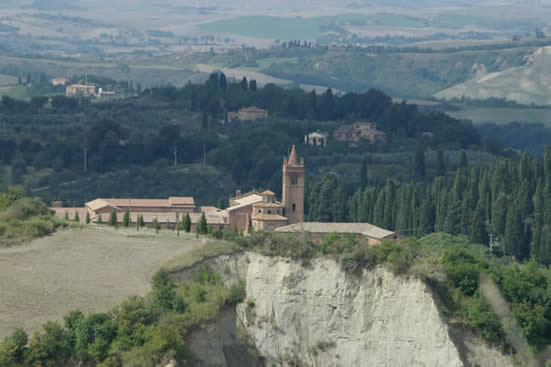
Photo by Peuplier via Wikimedia
About an hour from Barontoli. The road to Monteoliveto turns off the SS 2 (via Cassia) at Buonconvento. The SS 2 Cassia can be reached by going up to Siena, or else by a beautiful drive across the mountains. To go the latter way, drive through San Rocco onto the main Grosseto road. After about 8 km turn left towards Fontazzi. Go through Fontazzi to Casciano di Murlo and turn right at the T-junction towards Vescovaldo di Murlo. After about two kilometers, turn right towards Vescovaldo di Murlo and SS 2 Cassia, and continue following signs to Vescovaldo di Murlo. When you reach Vescovaldo, drive through the village and start following signs to Buonconvento. When you enter the small town of Buonconvento, go straight ahead until you come out on to the SS 2 Cassia. Turn left onto the Cassia and then right to Monteoliveto, up a winding road through the “creti”, spectacular bare grey clay hills (reminiscent of the country through which Guidoriccio da Fogliano rides in the famous fresco in the Palazzo Pubblico) until you come to the red-brick monastery in its forest of pines and cypresses. Open 09.15-12.00 and 15.15-17.45 (17.00 in winter).
After parking the top (disabled people can drive down to the bottom), walk across the drawbridge and through the battlemented gatehouse decorated on each side with della Robbia style terracotta plaques – the Madonna and Child with Angels on the outside and St Benedict on the inside. There is then a choice of descents through the cypresses to the monastery: the old rough brick path straight ahead and the winding new road able to take cars on the right. Halfway down the path is the monks’ fishpond, dating from 1533, now with only a little stagnant water in it.
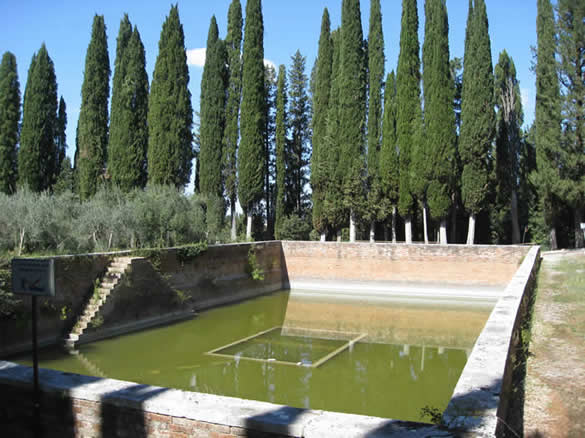
The great redbrick monastery at the bottom was founded by a Sienese nobleman, Giovanni Tolomei, who deserted the riches of Siena in 1313 for the simple life and started the “Olivetan” order of monks under Benedictine rule. The monastery remained in being until it was suppressed by Napoleon in 1810. There are now monks there again, but only a few; they specialise in restoring ancient manuscripts.
The cloister
The 15th century cloister is on the right, beyond the church. Its walls are covered with a marvellous cycle of frescoes depicting the life of St Benedict (who lived from about 480 to 550) as retailed by his near contemporary, St Gregory the Great. They are full of fascinating and lively detail. Eight of the 36 are by Luca Signorelli who worked on them from 1497-8. He was originally commissioned to do the whole lot but got bored and walked off the job part way through. The remainder are by Sodoma and were painted between 1505-8.
The cycle starts on the left of the far wall opposite the entrance (next to the entrance into the church, as that would have been the monks’ normal entrance to the cloister). Each fresco has its title underneath in Italian. The first frescoes are all by Sodoma and are:
- Benedict leaving home in Norcia as a young man to study in Rome, with his parents on the left bidding him a sorrowful good-bye, and his faithful nurse on a donkey ready to accompany him.
- Benedict leaving the college in Rome – which he found too hedonistic - to withdraw to a life of prayer (he can be seen creeping out on the right).
- Benedict miraculously mends a broken tray (according to legend, his nurse had borrowed the tray to pick through some grain and had broken it; the woman who owned the tray began to weep and Benedict, touched, prayed to God and the tray was mended). The swashbuckling young man in the foreground with the white gloves is a self-portrait of Sodoma with some of the animals he adopted to keep him company while he was painting the cloister.
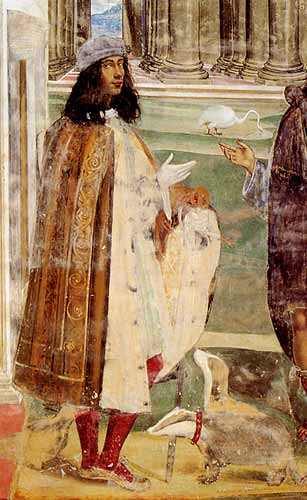
- The holy monk Romano gives Benedict a hermit’s habit. The town in the background is Subiaco, where Benedict founded his first monastery. This and the next fresco have some of the best scenery.
- Benedict at prayer in front of the cave in which he lived during his three years as a hermit; and the devil hurling a stone (from top left) and breaking the bell of Benedict’s bread basket. The monk Romano used to lower food to Benedict in this basket, ringing the bell to warn him it was coming. The devil apparently became so irritated by all this holy hermitry that he decided to destroy the bell.
- A priest (on the right, looking up) is inspired by Christ to take a meal (complete with servitor) to Benedict (still being a hermit in the desert) on Easter day. Note how Benedict’s designer stubble in the previous fresco is growing and will soon be a flowing beard.
- Benedict preaches to a group of peasants.
- Benedict overcomes temptation – in the form of a beautiful horned woman hovering above – by throwing himself naked into some brambles (right), while the Archangel Michael chases the temptress away. The left of the picture shows him struggling visibly with the temptation: rather a good bit of characterisation by Sodoma.
- Benedict agrees to an invitation from a group of hermits to become their superior, thus beginning his monastic career. Their hermitage can be seen in the background.
- Benedict – by making the sign of the cross – shatters a glass of wine that has been poisoned by some of his monks who found his monastic rule too strict. The monks can be seen preparing the poisoned drink at the end of a corridor.
- Benedict founds twelve communities of monks – note the interesting illustration of mediaeval building techniques.
- Benedict welcomes two youths, Mauro and Placido, into the order – they have arrived from Rome accompanied by an impressive retinue of family and followers.
- Benedict chases the devil from a monk who has become possessed, by beating him (on the right). The possession seems to have taken the form of following the devil’s invitation to go for a walk outside the monastery – see in the middle the devil pulling the robe of the errant monk. To the top right Benedict can be seen forgiving the monk while the frustrated devil above flees the scene.
- After having been entreated by the monks (in the left hand corner), who do not have enough water for their needs, Benedict produces water from the mountain.
- Benedict retrieves the blade of a scythe which has become detached from its handle (left) and fallen into a lake – see how it miraculously reattaches itself to its handle (middle).
- Mauro is sent to save Placido from drowning, walking miraculously on the water to do so. On the left, Benedict, who has had a miraculous vision of the accident, is telling Mauro to go to the lake.
- (Over the door) Benedict changes a flask of wine into a serpent. An errand boy was supposed to deliver two flasks but hid one on the way. On the left he delivers the remaining one, and on the right he goes back to recover the other only to find the wine transformed into a serpent.
- The wicked monk Fiorenzo (Florentius), envious of Benedict’s reputation, tries to poison Benedict with a poisoned loaf, but Benedict realises what he is doing and gives the bread to a crow with a request to the crow that it carry the bread far away where it will harm no-one.
- Fiorenzo’s next exploit is to send a number of loose women into the monastery to tempt the monks. Sodoma originally painted them naked, but the abbot of the time was so shocked that he forced Sodoma to paint clothes on them. Benedict sees them coming from the balcony above, and decides to take all the monks off on an expedition to avoid temptation (bottom left).
- Benedict sends Mauro to France and Placido to Sicily on missions of evangelisation. This fresco is by Bartolomeo Neroni, also called Il Riccio, who was Sodoma’s son-in-law.
The next eight frescoes on this wall are by Luca Signorelli. Given that they were painted before Sodoma came on the scene, it is strange that Signorelli chose to begin in the middle of St Benedict’s life. Signorelli’s style is less pretty but more powerful and spiritual than Sodoma’s, with no pet animals to distract from the main theme.
- God causes Fiorenzo’s death by making a house collapse on top of him. Devils can be seen raging against the falling building at top left and carrying off his soul at the top right. In the foreground a monk comes to tell Benedict the news, but Benedict reproves him for showing too much pleasure at Fiorenzo’s death.
- Benedict converts the inhabitants of Montecassino. The monks in the background are pulling down a statue of Apollo, still worshipped there when Benedict arrived (shades of the toppling of Saddam Hussein’s statue in Baghdad).
- Benedict defeats the devil with the sign of the cross – the devil had bewitched a block of stone being used to build a monastery, making it too heavy to lift.
- Benedict brings back to life a young monk on whom a wall had collapsed. The accident is seen happening top left, with the lifeless monk being carried to St Benedict below.
- Benedict catches out two monks who are dining outside the monastery without permission. When they returned to the monastery and were asked where they had gone, thinking themselves undetected they replied “nowhere”, but Benedict was miraculously able to tell them (top right) exactly where they had been.
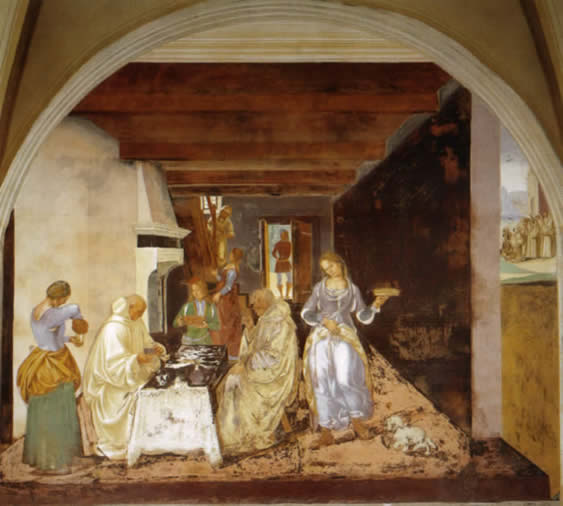
- Benedict reproaches the brother of the monk Valerian for having broken his fast after being tempted by a wayfarer (on the right).
- Benedict unmasks Riggo, who had disguised himself as Totila, king of the Goths. Riggo was Totila’s shield-bearer and had been sent in disguise by Totila to see if Benedict really had holy powers or could be deceived by the disguise. The scene at the top shows Riggo back at Totila’s campsite telling him what happened.
- Benedict recognises and receives Totila, who has come in person to make amends for his failed attempt at deception.
The next fresco was destroyed when the door was enlarged. The following ones are again by Sodoma.
- Benedict foretells the destruction of Montecassino (by the Lombards in 581, the first of many destructions). Benedict is at the top right.
- Benedict miraculously obtains flour for his monks. Flour had been running short at the monastery, but Benedict told the monks not to despair and the next day sacks of flour duly arrived (on the left). It is unclear whether the meal on the right is before or after the flour arrived; the provisions certainly look a little sparse.
- Benedict appears to two far-away monks in their sleep and tells them how to build a monastery.
- Benedict first excommunicates two nuns for bad behaviour and then absolves them after their death. A somewhat curious scene: the two women were buried in consecrated ground next to the church and, during mass (being celebrated in the centre of the picture), at a point where the deacon asks excommunicated people to leave, the nuns rise from their tombs (left). The subsequent absolution is shown on the other side.
- Benedict has the Sacred Host placed on the body of a monk that the ground had refused to receive – the ground had apparently done this because the monk, before dying, had disobeyed Benedict.
- Benedict forgives a monk who had fled from the monastery – the monk had come back to the monastery after meeting a monster on the road (on the right).
- Benedict miraculously releases with a look a man who had been tied up by a Goth (Goths were all-purpose enemies at the time). The Goth wanted the man to hand over his belongings (in the background on the right), but he said that he had given them to Benedict. The Goth drags him to Benedict’s monastery and reiterates his demand, whereupon Benedict exercises his miraculous glance.
The church
Beyond this last fresco a passage (decorated with more frescoes by Sodoma) leads into the church, built between 1400 and 1417 in the Gothic style. The best things in it are the choir stalls, decorated with the most beautiful inlaid wood – 16th century “intarsia” work – scenery, birds and animals. There is more intarsia on the lectern in the middle, including a wonderful and much reproduced tabby cat. One of the three chapels contains a large wooden crucifix brought to the monastery by its Tolomei founder in 1313; the crucifix allegedly spoke to Tolomei on a number of occasions.
The Library
For a long time, the Library was closed because visitors had stolen some of the rare documents from it. But it has now been reopened and can be reached up a stairway from the cloister, although most of the manuscripts are now securely locked away. Up some stairs at the end of the room there is an exceptional collection (because so complete) of blue and white pottery medicine jars from the monastery’s pharmacy. Rooms off the library have a mediocre collection of paintings, although there is one room of quite attractive water-colours of Monteoliveto itself.
There is quite a good little restaurant with a pleasant terrace at the top of the monastery drive, called La Torre (closed on Tuesdays).
SAN GIOVANNI D’ASSO
If you are not sated with sightseeing after Monteoliveto, go on up the road to the village of San Giovanni d’Asso (through Chiusure and right at the T-junction). San Giovanni has an attractive castle. From the village car-park one can wander in through the main gate, noticing the remains of Gothic windows; walk through a courtyard with a renaissance brick loggia; and leave through the door on the other side, emerging into a little square with spectacular views to the right (and also a small Romanesque church).
One can then return through the castle and follow the signs from the car-park to the village, where there is another Romanesque church, San Piero in Villore. Its ancient façade is decorated with blind arches and strange primitive sculptures – the stone to the left of the door has a particularly macabre scene of two wolves each eating an arm of an unfortunate man trapped between them. Up the main street there is a bar with a panoramic view.
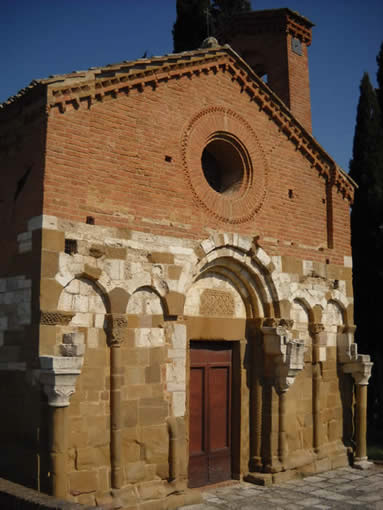
Photo from Wikimedia Commons
1994 and 2004